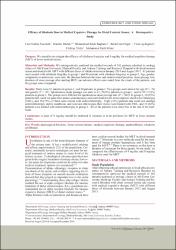| dc.contributor.author | Yuceturk, Cem Nedim | |
| dc.contributor.author | Dadali, Mumtaz | |
| dc.contributor.author | Bagbanci, Muhammed Sahin | |
| dc.contributor.author | Ozgur, Berat Cem | |
| dc.contributor.author | Aydogmus, Yasin | |
| dc.contributor.author | Yildiz, Yildiray | |
| dc.contributor.author | Kilinc, Muhammet Fatih | |
| dc.date.accessioned | 2019-11-24T21:01:45Z | |
| dc.date.available | 2019-11-24T21:01:45Z | |
| dc.date.issued | 2017 | |
| dc.identifier.issn | 1735-1308 | |
| dc.identifier.issn | 1735-546X | |
| dc.identifier.uri | https://hdl.handle.net/20.500.12513/3560 | |
| dc.description | WOS: 000397175400002 | en_US |
| dc.description | PubMed ID: 28116737 | en_US |
| dc.description.abstract | Purpose: We aimed to investigate the efficacy of silodosin 4 mg/day and 8 mg/day for medical expulsive therapy (MET) of lower ureteral stones. Materials and Methods: We retrospectively analyzed the medical records of 161 patients admitted to urology clinics of Ahi Evran University Medical Faculty and Ankara Training and Research Hospital with distal ureteral stones and treated with MET with different doses of silodosin between January 2013 and August 2015. 81 patients were treated with silodosin 4mg/day in group-1 and 80 patients with silodosin 8mg/day in group-2. Age, gender, complaints on admission, stone size, the distance between the stone and ureterovesical junction, stone passage rate, duration of stone passage after starting MET, and adverse effects were noted from the charts of the patients, and the groups were compared. Results: There were 81 patients in group-1, and 80 patients in group-2. Two groups were similar for age (P =.38) and gender (P =.92). Spontaneous stone passage was seen in 41 (50.9%) patients in group-1, and in 59 (73.8%) patients in group 2. The groups were different for spontaneous stone passage rate (P =.002). In group-1, 10 (25%) patients that could not pass their stones spontaneously and were treated with extracorporeal shockwave lithotripsy (SWL), and 30 (75%) of them were treated with ureterolithotripsy. Eight (38%) patients that could not undergo ureterolithotripsy and/or anesthesia and were not able to pass their stones were treated with SWL, and 13 (62%) patients were treated with ureterolithotripsy in group-2. All of the patients were stone free at the end of the treatment. Conclusion: A dose of 8 mg/day should be preferred if silodosin is to be preferred for MET in lower ureteral stones. | en_US |
| dc.language.iso | eng | en_US |
| dc.publisher | UROL & NEPHROL RES CTR-UNRC | en_US |
| dc.rights | info:eu-repo/semantics/closedAccess | en_US |
| dc.subject | adrenergic alpha-blockers | en_US |
| dc.subject | lower ureteral stones | en_US |
| dc.subject | medical expulsion therapy | en_US |
| dc.subject | nephrolithiasis | en_US |
| dc.subject | silodosin | en_US |
| dc.subject | urolithiasis | en_US |
| dc.title | Efficacy of Silodosin Dose in Medical Expulsive Therapy for Distal Ureteral Stones: A Retrospective Study | en_US |
| dc.type | article | en_US |
| dc.relation.journal | UROLOGY JOURNAL | en_US |
| dc.contributor.department | Kırşehir Ahi Evran Üniversitesi, Tıp Fakültesi, Cerrahi Tıp Bilimleri, Üroloji ABD | en_US |
| dc.identifier.volume | 14 | en_US |
| dc.identifier.issue | 1 | en_US |
| dc.identifier.startpage | 2944 | en_US |
| dc.identifier.endpage | 2948 | en_US |
| dc.relation.publicationcategory | Makale - Uluslararası Hakemli Dergi - Kurum Öğretim Elemanı | en_US |


















